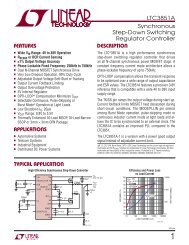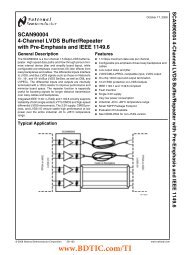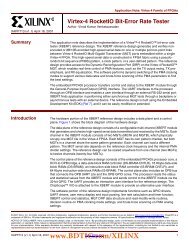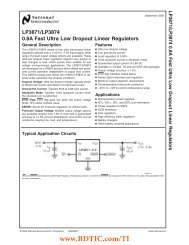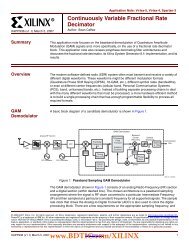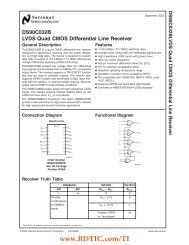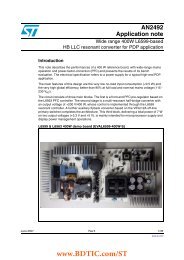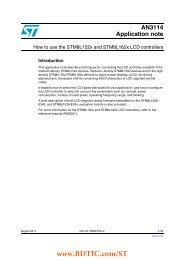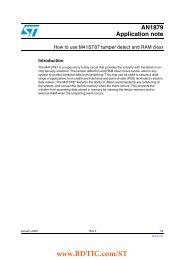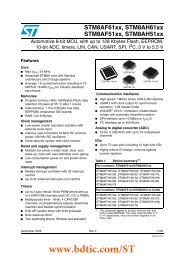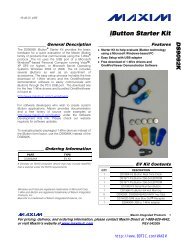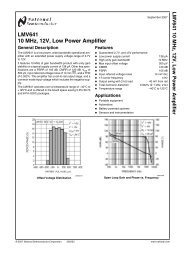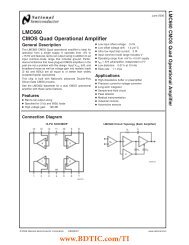ADuC841/ADuC842/ADuC843 MicroConverter Multichannel 12-Bit ...
ADuC841/ADuC842/ADuC843 MicroConverter Multichannel 12-Bit ...
ADuC841/ADuC842/ADuC843 MicroConverter Multichannel 12-Bit ...
You also want an ePaper? Increase the reach of your titles
YUMPU automatically turns print PDFs into web optimized ePapers that Google loves.
Anomaly Sheet for Silicon Rev. E<br />
<strong>MicroConverter</strong> ® <strong>Multichannel</strong> <strong>12</strong>-<strong>Bit</strong> ADC with<br />
Embedded 62 kB Flash and Single-Cycle MCU<br />
<strong>ADuC841</strong>/<strong>ADuC842</strong>/<strong>ADuC843</strong><br />
This anomaly list represents the known bugs, anomalies, and workarounds for the <strong>ADuC841</strong>, <strong>ADuC842</strong>, and <strong>ADuC843</strong> <strong>MicroConverter</strong><br />
products. The anomalies listed apply to all <strong>ADuC841</strong>/<strong>ADuC842</strong>/<strong>ADuC843</strong> packaged material branded as follows:<br />
First(CSP) /Second (PQFP) Line<br />
Third (CSP) / Fourth Line (PQFP)<br />
<strong>ADuC841</strong> or <strong>ADuC842</strong> or <strong>ADuC843</strong><br />
E20<br />
Analog Devices, Inc. is committed, through future silicon revisions, to continuously improving silicon functionality. Analog Devices tries<br />
to ensure that these future silicon revisions remain compatible with your present software/systems implementing the recommended<br />
workarounds outlined here.<br />
<strong>ADuC841</strong>/<strong>ADuC842</strong>/<strong>ADuC843</strong> SILICON REVISION HISTORY<br />
Silicon<br />
Revision<br />
Identifier<br />
Kernel<br />
Revision<br />
Identifier Chip Marking Silicon Status Anomaly Sheet No. of Reported Anomalies<br />
E 0 All silicon branded<br />
Release Rev. 0 8<br />
ADUC841BS or <strong>ADuC841</strong>BCP<br />
<strong>ADuC842</strong>BS or <strong>ADuC842</strong>BCP<br />
<strong>ADuC843</strong>BS or <strong>ADuC843</strong>BCP<br />
E 0<br />
www.BDTIC.com<br />
Third/Fourth Line: E20<br />
All silicon branded<br />
Release Rev. A 11<br />
ADUC841BS or <strong>ADuC841</strong>BCP<br />
<strong>ADuC842</strong>BS or <strong>ADuC842</strong>BCP<br />
<strong>ADuC843</strong>BS or <strong>ADuC843</strong>BCP<br />
Third/Fourth Line: E20<br />
Rev. A<br />
Information furnished by Analog Devices is believed to be accurate and reliable.<br />
However, no responsibility is assumed by Analog Devices for its use, nor for any<br />
infringements of patents or other rights of third parties that may result from its use.<br />
Specifications subject to change without notice. No license is granted by implication<br />
or otherwise under any patent or patent rights of Analog Devices. Trademarks and<br />
registered trademarks are the property of their respective owners.<br />
One Technology Way, P.O. Box 9106, Norwood, MA 02062-9106, U.S.A.<br />
Tel: 781.329.4700<br />
www.analog.com<br />
Fax: 781.326.8703 © 2004 Analog Devices, Inc. All rights reserved.
<strong>ADuC841</strong>/<strong>ADuC842</strong>/<strong>ADuC843</strong><br />
ANOMALIES<br />
1. Mode 0 UART Operation [er001]<br />
Background: UART Mode 0 allows the UART to function in an 8-bit shift register mode.<br />
Issue:<br />
UART Mode 0 is nonfunctional on the <strong>ADuC841</strong>/<strong>ADuC842</strong>/<strong>ADuC843</strong>.<br />
Workaround: None.<br />
Related Issues: None.<br />
2. Use of the Extended Stack Pointer [er002]<br />
Background: The extended stack pointer allows the stack to overflow into internal XRAM.<br />
Issue:<br />
A PUSH onto the extended stack when it is the first instruction within a subroutine results in the return address being<br />
overwritten.<br />
Workaround: For Assembly code, insert a NOP as the first instruction in any subroutine.<br />
For C code, there is currently no workaround.<br />
Related Issues: None.<br />
3. Use of I 2 C in Slave Mode with Stop Interrupt Enabled [er003]<br />
Background:<br />
Issue A:<br />
Workaround A:<br />
Issue B:<br />
Workaround B:<br />
Related Issues:<br />
In slave mode, the I 2 C interface can be configured to generate an interrupt due to a start, repeated start, data, or stop<br />
condition. The I 2 C interrupt decode bits (I2CID0 and I2CID1) in I2CCON indicate the source of the interrupt. If the stop<br />
interrupt is enabled via the I2CSI bit, an interrupt is generated when the slave receives a stop condition.<br />
In the I 2 C interrupt service routine, if the I2CI bit or I2CDAT register is accessed during a stop interrupt, the I 2 C bus will<br />
fail to respond to further I 2 C communication.<br />
When a stop interrupt is detected, the user should reset the I 2 C bus by using the I2CRS bit.<br />
When the stop interrupt is enabled, on occasion the I 2 C interrupt decode bits indicate that a start, repeated start, or<br />
DATA interrupt occurred when the source was in fact a stop interrupt. If this happens the user may try to clear I2CI or<br />
read I2CDAT, resulting in the bus failing to respond to further I 2 C communication.<br />
Tie the SCLOCK pin to an I/O pin; This allows the state of SCLOCK to be read. SCLOCK is high only during an interrupt if<br />
the source is a stop interrupt.<br />
er004: Use of I 2 C in slave mode with stop interrupt disabled.<br />
www.BDTIC.com<br />
4. Use Of I 2 C in Slave Mode with Stop Interrupt Disabled [er004]<br />
Background:<br />
Issue:<br />
Workaround:<br />
Related Issues:<br />
In slave mode, the I 2 C interface can be configured to generate an interrupt due to a start, repeated start, data, or stop<br />
condition. The I 2 C interrupt decode bits (I2CID0 and I2CID1) in I2CCON indicate the source of the interrupt.<br />
Once one repeated start is detected by the I 2 C interface, all subsequent start conditions are detected as a repeated<br />
start even if a stop bit has been received between data transfers.<br />
None.<br />
None.<br />
5. I 2 C Data Transfer [er005]<br />
Background: The I2CDAT register is used to read or write data to the I 2 C bus. The I2CDAT register has an SFR address of 0x9A.<br />
Issue A:<br />
During an I 2 C transfer if a user accesses the RAM address 0x9A the contents of the I2CDAT SFR can be modified.<br />
Workaround A: For Assembly code: Do not use memory location 0x9A<br />
For C code: Assign a dummy variable to location 0x9A using the following code:<br />
idata unsigned int ui32Dummy[2] _at_ 0x9A;<br />
Issue B:<br />
During an I 2 C transfer, if a user executes either of the following instructions, the contents of the I2CDAT SFR can be<br />
modified.<br />
MOV dest,#9AH<br />
SUBB A,R2<br />
Workaround B: To prevent code from changing the contents of the I2CDAT SFR make sure that neither of these instructions are<br />
executed during an I 2 C transfer.<br />
Issue C:<br />
A small percentage (
<strong>ADuC841</strong>/<strong>ADuC842</strong>/<strong>ADuC843</strong><br />
6. SPI Interface [er006]<br />
Background: The SPI can either be used on the standard pins or can be moved to P3.3, P3.4, and P3.5 by setting the MSPI bit in<br />
CFG841/CFG842. When the MSPI bit is set, P3.3 should be MISO, P3.4 MOSI, and P3.5 SCLOCK.<br />
Issue A:<br />
By setting the MSPI bit, the P3.3, P3.4, and P3.5 have the following configuration:<br />
P3.3 = MISO, P3.4 = SCLOCK, P3.5 = MOSI<br />
Workaround A: None.<br />
Issue B:<br />
When the <strong>ADuC841</strong>/<strong>ADuC842</strong>/<strong>ADuC843</strong> is set up as an SPI slave, the device may receive or transmit bytes incorrectly.<br />
Workaround B: Incorporate checksums into all communication with the <strong>ADuC841</strong>/<strong>ADuC842</strong>/<strong>ADuC843</strong> slave. This allows the master<br />
devices to retransmit if an error occurs.<br />
Related Issues: None.<br />
7. Interrupts During Reading/Writing to Data FLASH/EE [er007]<br />
Background: There are 4 kB of DATAFLASH/EE that can be used for nonvolatile data storage.<br />
Issue:<br />
If an interrupt occurs during a DATAFLASH/EE read or write operation, code execution following the ISR may resume at<br />
a random program memory address.<br />
Workaround: Disable all interrupts prior to a read or write operation. This can be done by setting the EA bit to 0.<br />
Related Issues: None.<br />
8. PWM Operation [er008]<br />
Background: The PWM output rate is determined by the PWMxH and PWMxL registers for the PWM0 and PWM1 outputs.<br />
Issue:<br />
Modifying RAM Address 0x2E causes the PWM timer to be reset.<br />
Workaround: For Assembly code: Do not use memory location 0x2E.<br />
For C code:<br />
Assign a dummy variable to location 0x2E using the following code:<br />
idata unsigned int ui32Dummy[2] _at_ 0x2E;<br />
Related Issues: None.<br />
www.BDTIC.com<br />
9. Watchdog Timer [er009]<br />
Background: The <strong>ADuC841</strong>, <strong>ADuC842</strong>, and <strong>ADuC843</strong> incorporate a Watchdog Timer. The purpose of the WDT is to ensure the part is<br />
never stuck in an endless loop by generating either a hardware reset or an interrupt event that vectors to the WDT ISR.<br />
Issue:<br />
If the WDT generates an interrupt as opposed to a hardware reset, and if the ISR subsequently sets up the WDT to time<br />
out to a hardware reset, the reset is ignored.<br />
Workaround: Ensure that a double write to the WDCON is executed inside the ISR with the first write being a reset of the WDT. For<br />
example:<br />
void isr_wdt( void ) interrupt 11<br />
{<br />
WDWR = 1; // This first WDT write is required to get the WDT to work inside the ISR.<br />
WDCON = 0x60;// Reset WDT.<br />
WDWR = 1; // Now set the WDT to the required 1s timeout<br />
WDCON = 0x62;// select reset after 1000mS<br />
while(1);<br />
}<br />
void main(void)<br />
{<br />
EA = 0;<br />
WDWR = 1; // Allow write to WDCON<br />
WDCON = 0x6A; // timeout=1000mS, WDT enable, WDT ISR Interrupt<br />
while (1);<br />
}<br />
Related Issues: None.<br />
Rev. A | Page 3 of 4
<strong>ADuC841</strong>/<strong>ADuC842</strong>/<strong>ADuC843</strong><br />
10. Level Triggered Interrupt Operation [er010]<br />
Background: The <strong>ADuC841</strong>/<strong>ADuC842</strong>/<strong>ADuC843</strong> incorporate two external interrupt sources (INT0 and INT1) that can be configured to<br />
respond to either an edge event or a level event.<br />
Issue:<br />
If an interrupt occurs on the INT0 or INT1 pins and is then removed within one core instruction cycle, the interrupt vector<br />
address that is generated may be incorrect resulting in a vector to 0x0000. This effectively restarts code execution.<br />
Workaround: To ensure that this does not occur the level triggered interrupt source must be kept low for a minimum of 9 core clock<br />
cycles.<br />
Related Issues: None.<br />
11. Stack Pointer in ULOAD Mode [er011]<br />
Background: When starting user code, the stack pointer should, by default, be initialized to Address 0x07.<br />
Issue:<br />
In ULOAD mode, the stack pointer defaults to 0x03 causing conflict between RAM locations R4 to R7 and the stack.<br />
Workaround: Manually change, in code, the stack pointer address to 0x07 or to the address that is required upon entry to ULOAD<br />
mode, that is,<br />
MOV SP, #07H<br />
or<br />
SP = 0x07;<br />
Related Issues: None.<br />
<strong>ADuC841</strong>/<strong>ADuC842</strong>/<strong>ADuC843</strong> SILICON ANOMALIES<br />
www.BDTIC.com<br />
Anomaly No. Description Status<br />
er001 Mode 0 UART Operation Pending<br />
er002 Use of the Extended Stack Pointer Pending<br />
er003 Use of I 2 C in Slave Mode with Stop Interrupt Enabled Pending<br />
er004 Use Of I 2 C in Slave Mode with Stop Interrupt Disabled Pending<br />
er005 I 2 C Data Transfer Pending<br />
er006 SPI Interface Pending<br />
er007 Interrupts During Reading/Writing to Data FLASH/EE Pending<br />
er008 PWM Operation Pending<br />
er009 Watchdog Timer Pending<br />
er010 Level Triggered Interrupt Operation Pending<br />
er011 Stack Pointer in ULOAD Mode Pending<br />
Purchase of licensed I 2 C components of Analog Devices or one of its sublicensed Associated Companies conveys a license for the purchaser under the Philips I 2 C Patent<br />
Rights to use these components in an I 2 C system, provided that the system conforms to the I 2 C Standard Specification as defined by Philips.<br />
© 2004 Analog Devices, Inc. All rights reserved. Trademarks and<br />
registered trademarks are the property of their respective owners.<br />
S03260–0–7/04(A)<br />
Rev. A | Page 4 of 4



